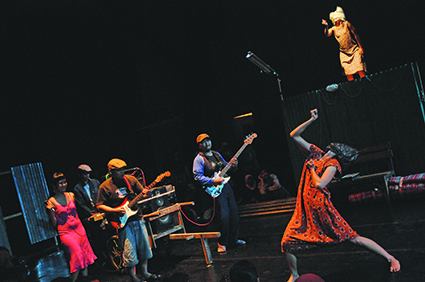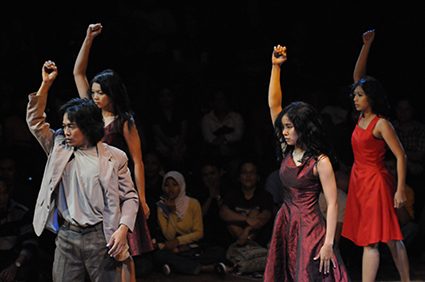Creating togetherness, making democracy
Ben Brooker: Teater Garasi, The Streets

The Streets, Teater Garasi, OzAsia
photo courtesy OzAsia 2015
The Streets, Teater Garasi, OzAsia
The first thing I noticed at the launch of this year’s OzAsia Festival–the ninth since its inception by Adelaide Festival Centre CEO Douglas Gauthier in 2006–was the branding. Absent were the Chinese dragons and awkward ‘east meets west’ juxtapositions of previous festivals. In their place is a neon-style logo of lurid, downtown pink set against an imageless black void. In its lean, steely contemporariness, it’s the kind of branding that wouldn’t look out of place on a poster or press release for any major international arts festival.
This is no accident. The word “contemporary” recurs frequently throughout this year’s program, just as it peppered the speeches given at the launch by Gauthier and OzAsia Artistic Director Joseph Mitchell. Last year it was announced Mitchell would replace Jacinta Thompson as director, a role Thompson had filled for seven years, and it’s evident that Mitchell’s leadership will entail a renewed focus on work by a younger generation of Asian artists with hybrid and formally inventive practices. It’s a reinvigoration that will see a shorter but fuller festival—41 events over 11 days, as opposed to last year’s 18—and one that will extend its footprint from the Adelaide Festival Centre to the surrounding Riverbank precinct.
The Streets
Emblematic of Mitchell’s fresh approach is the program’s inclusion of The Streets, an immersive dance-theatre work by Indonesia’s highly regarded Teater Garasi and directed by founding member Yudi Ahmad Tajudin. Begun in 2007, The Streets (in Indonesian it literally means ‘crammed’ and ‘the street’) was informed by six months’ worth of interviews and field research undertaken by the company’s multidisciplinary collective of artists—actors, writers, musicians, visual artists—amid the hustle and bustle of urban hubs such as Jakarta and Yogyakarta, the culturally rich ‘Special Region’ in Java where Teater Garasi formed at Gadjah Mada University in 1993.
When I spoke with Tajudin, he told me that some of the performers lived on the street during this period of the work’s development while others recorded conversations with hawkers or established contact with homeless children. Each engaged in what Tajudin calls the ‘embodying process,’ an intense submersion in the vibrant and sometimes harsh realities of urban nightlife in Indonesia, observing the complex negotiations of class, faith and ethnicity brought to the surface by the dissolution of Suharto’s repressive New Order in 1998. “Indonesia as a society,” Tajudin says, “still has to learn how to deal with our own diversity. For 32 years we were kind of situated in this fake stability, which suppressed our diversity. Once it’s open, all these voices, all these narratives, all this ideology comes out. So now we have to deal with it, learn about it. That’s still the main issue for me in Indonesia. That’s why, with The Streets, we wanted to make such investigations.”

The Streets, Teater Garasi, OzAsia
photo courtesy OzAsia 2015
The Streets, Teater Garasi, OzAsia
These tensions are assayed in the work by jostling, overlapping encounters with sex workers and street sellers, Muslims and Islamists, leisured tourists and hectoring officials. Audience members, Tajudin explained, are situated experientially, given agency to choose where to sit or stand, and whether or not to move if their view becomes obstructed: “Just like in the street in Indonesia, some people occupy one area and maybe other people force them to move.” What begins as a scene of apparent chaos is woven into a tightly choreographed mosaic, the work also drawing in poetry, academic and essayistic writing and improvisations inspired by found objects such as an umbrella. When The Streets was performed in Jakarta in 2008, Tajudin had one of the performers deliver to a VIP section of the audience a monologue about a tempe (soybean cake) seller who suicides when the global price of soybeans surges. “I don’t know whether it will work here,” Tajudin mused. When he told me, intriguingly, that older, wealthier audiences in Jakarta ultimately “viewed the work as sad, but younger, lower class audiences as a celebration,” I suggested the provocatively placed monologue may have been a factor. He didn’t deny this and I saw, behind the warm, generous demeanor I have heard is not untypical of Yogyakarta artists, a flicker of a younger Tajudi—angry, wary—the political science undergrad for whom theatre provided a natural vocabulary of dissent.
Later, Tajudin will tell me that several Indonesian theatre companies met the Suharto regime’s demise with their own, unable to endure without their raison d’être–a binding antipathy towards the New Order. For Teater Garasi, the end of the Suharto era precipitated a recalibration rather than a fatal loss of purpose, a shift from a vertical perspective—David with his sling staring up at the Goliath of the state—to a horizontal one where democracy has opened up the social sphere to emergent voices, including, as Tajudin pointed out, “those voices who want the space for themselves.” During the colourful disorder with which The Streets begins, a narrator steps forward and poses what, for Tajudin and many of his fellow Indonesians, is the big question the country faces as those voices, often as unequal in their access to power and capital as they were pre-democracy, clamour to be heard: “kita mau kemana?—where are we going?”
“When we started,” Tajudin reflected as our conversation drew to a close, “I had to find a belief, the function, the role of this kind of art. So there’s this old idea that theatre is a ritual, ceremonial, so I think from the very beginning it’s about encounters. It’s about contact. It’s about how to create”—and here he pauses, scrabbling interiorly for the right word in English—“togetherness. When everybody is aware of somebody else’s presence without mediation. Especially, maybe at this time, theatre is becoming more important. That’s why I’m still doing this. We need that.”
OzAsia Festival 2015, Teater Garasi, The Streets, Space Theatre, Adelaide Festival Centre, 24-26 Sept
RealTime issue #128 Aug-Sept 2015 pg. 20






